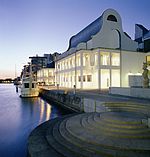Helsingborg Arena
21st-century establishments in Skåne CountyBuildings and structures in HelsingborgHandball venues in SwedenSport in HelsingborgSports venues completed in 2012 ... and 4 more
Sports venues in the Øresund RegionSwedish sports venue stubsTourist attractions in HelsingborgTourist attractions in Skåne County

Helsingborg Arena is a multipurpose arena in Helsingborg, Sweden, run by and associated with the municipal companies Helsingborg Events and Idrottspark AB and Helsingborg Arena and Scen AB, respectively.
Excerpt from the Wikipedia article Helsingborg Arena (License: CC BY-SA 3.0, Authors, Images).Helsingborg Arena
Västgötagatan, Helsingborg Wilson park
Geographical coordinates (GPS) Address Nearby Places Show on map
Geographical coordinates (GPS)
| Latitude | Longitude |
|---|---|
| N 56.053 ° | E 12.7043 ° |
Address
Västgötagatan
252 76 Helsingborg, Wilson park
Sweden
Open on Google Maps











